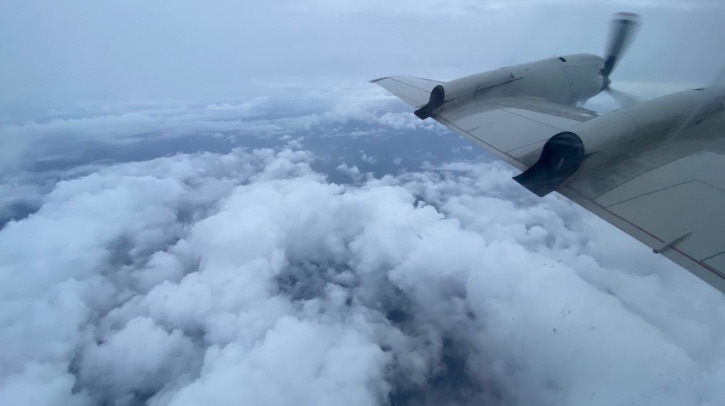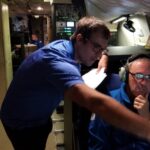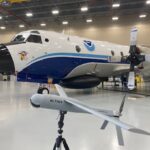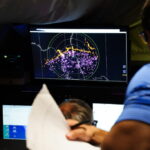As a result of the extreme turbulence experienced by NOAA’s WP-3D Orion Hurricane Hunter aircraft ‘Kermit’ (NOAA42) flight through Hurricane Ian, researchers have created new metrics to better quantify turbulence. In a study presented in May 2024 by Joshua Wadler of Embry-Riddle Aeronautical University at the 36th Conference on Hurricanes and Tropical Meteorology, the researcher explained that they sought to improve the understanding of turbulence because of its increasingly important global impact given its predicted increase due to climate change.
A bumpiness equation
The flight, which took place on September 28, 2022, reportedly ranked as the top 10 flights in Hurricane Hunter history, and potentially the most turbulent ever on a Hurricane Hunter aircraft, at least in the past 20 years. Metrics for turbulence already exist, but most of those only represent vertical motion and focus on atmospheric properties rather than what happens to occupants. “We wanted… to have a 3D turbulence metric and one that describes the human experience,” said Wadler.
The team highlighted that when an aircraft rapidly accelerates vertically or horizontally, everyone feels the dizzying rise or stomach-clenching drop. However, if the aircraft rotates around its center of gravity in any direction, that acceleration will have different effects depending on where someone is seated. For example, when the aircraft tilts (or pitches) upward the people in the front of the aircraft will feel an upward acceleration while the people in the back will feel a downward acceleration. If the plane is also accelerating upward, such as during take-off, those in the front will experience double the acceleration. As Wadler noted, “Every seat on the plane experiences different rotational motions depending on where you are.”
The new ‘bumpiness’ metric from Wadler and his colleagues accounts for those differences. The research team combined flight-level data from all P-3 flights since 2004 (when data of a sufficiently high quality became available). They calculated the acceleration forces acting on each seat in the plane relative to the plane’s center of gravity.
The team defined the flight’s bumpiness by combining acceleration with jerk (the rate of change in acceleration over time), accounting for both in all three dimensions. This equation can be applied to any aircraft where the center of gravity and relative positions of the seats are known, and for which high-quality flight-level data is available.

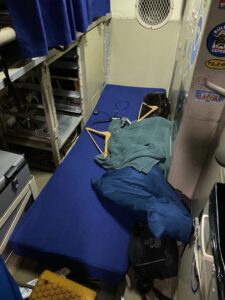
The equation accounts equally for bumpiness in all directions, although it can be thrown off by sharp turns. Missions in which the plane turned sharply on purpose (for example, to calibrate instruments) were excluded from the team’s calculations.
Because the end result, the B or bumpiness value, values all dimensions of movement equally, it doesn’t always sync with what people expect. Some Twitter commenters belittled the video from the flight, possibly because it shows few large up-and-down bumps. The main types of motion experienced by the mission’s crew, however, were front-to-back and side-to-side.
The bumpiest hurricane flights
The researchers calculated the top 10 bumpiest flights for each of the seats on the plane, based on the most turbulent part of each mission.
For the person in seat one (the pilot flying the plane in the front left seat), the Hurricane Ian flight was in fact the bumpiest by far – with a B value of 6.04m/s2, 34% bumpier than any other flight for which good data was available. The second highest B value was experienced during Hurricane Irma in 2017 (B value: 4.5m/s2), the third by a flight into Hurricane Sam in 2021 (B value: 4.39m/s2). Subjective rankings from surveyed flight crews came up with a wide range of answers about their bumpiest flights but were roughly in the same ballpark as those calculated by B value.
| Rank | Storm Name | Mission ID | Maximum Bumpiness Value (m/s2) |
| 1 | IAN | 20220928H1 | 6.04 |
| 2 | IRMA | 20170908H2 | 4.50 |
| 3 | SAM | 20210929H2 | 4.39 |
| 4 | LANE(EP) | 20180822H1 | 4.28 |
| 5 | FELIX | 20070902H1 | 4.27 |
| 6 | DORIAN | 20190830H2 | 4.08 |
| 7 | PATRICIA(EP) | 20151023I1 | 4.05 |
| 8 | RAFAEL | 20121015H1 | 4.02 |
| 9 | GONZALO | 20141017I1 | 3.90 |
| 10 | DORIAN | 20190904H1 | 3.70 |
Rankings of B values for Hurricane Hunter flights since 2004, for the pilot in seat 1
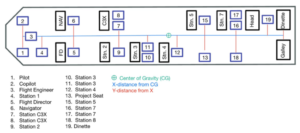
On the Hurricane Ian mission, the greatest B value (6.13m/s2) was experienced by the second pilot, sitting in seat two. Wadler was in seat 10. “I was very fearful during this mission,” he noted during his presentation. But, “lo and behold, my seat had the lowest [bumpiness] value by far.” The pilot in seat one experienced 37% worse turbulence than Wadler’s seat in the middle of the plane (6.04m/s2 versus 4.4m/s2).
| Seat | max Bumpiness (m/s2) |
| 1 | 6.04 |
| 2 | 6.13 |
| 3 | 6.02 |
| 4 | 5.87 |
| 5 | 5.52 |
| 6 | 5.68 |
| 7 | 5.03 |
| 8 | 5.08 |
| 9 | 4.79 |
| 10 | 4.4 |
| 11 | 4.46 |
| 12 | 4.45 |
| 13 | 4.54 |
| 14 | 4.52 |
| 15 | 4.45 |
| 16 | 4.53 |
| 17 | 4.51 |
| 18 | 4.59 |
| 19 | 4.55 |
Rankings of B values for all seats on the Hurricane Hunter flight 20220928H1
For seat 1, the Ian flight (Flight 20220928H1) ranked above all other flights for back-front and lateral motion. Yet in terms of up-down motion, a mission during Hurricane Lane ranked far higher, with a vertical B value of 17.1; Ian’s highest vertical B value was 8.43, ranking it seventh in terms of vertical motion. When all metrics are combined, however, the Ian flight came out on top. “It’s normal to have vertical bumps with eyewall updrafts and downdrafts,” Wadler noted in a later conversation, “but the lateral motions are rare. … the dropsondes went all over the cabin.”
Currently, the bumpiness rankings only count the highest B value experienced during a flight. In future work, the research team aims to develop an equation that can account for cumulative bumpiness over time – a ‘queasiness index’ and is well on the way to finding out what flights would make even the most iron-stomached hurricane hunter, in Wadler’s words, “very happy to be on the ground.”
In related news, NOAA’s National Weather Service (NWS) and GreenSight recently signed a one-year Cooperative Research and Development Agreement to deploy an uncrewed aircraft system, called WeatherHive, to measure atmospheric conditions and evaluate if the data could aid in weather forecasting. Click here to read the full story.


